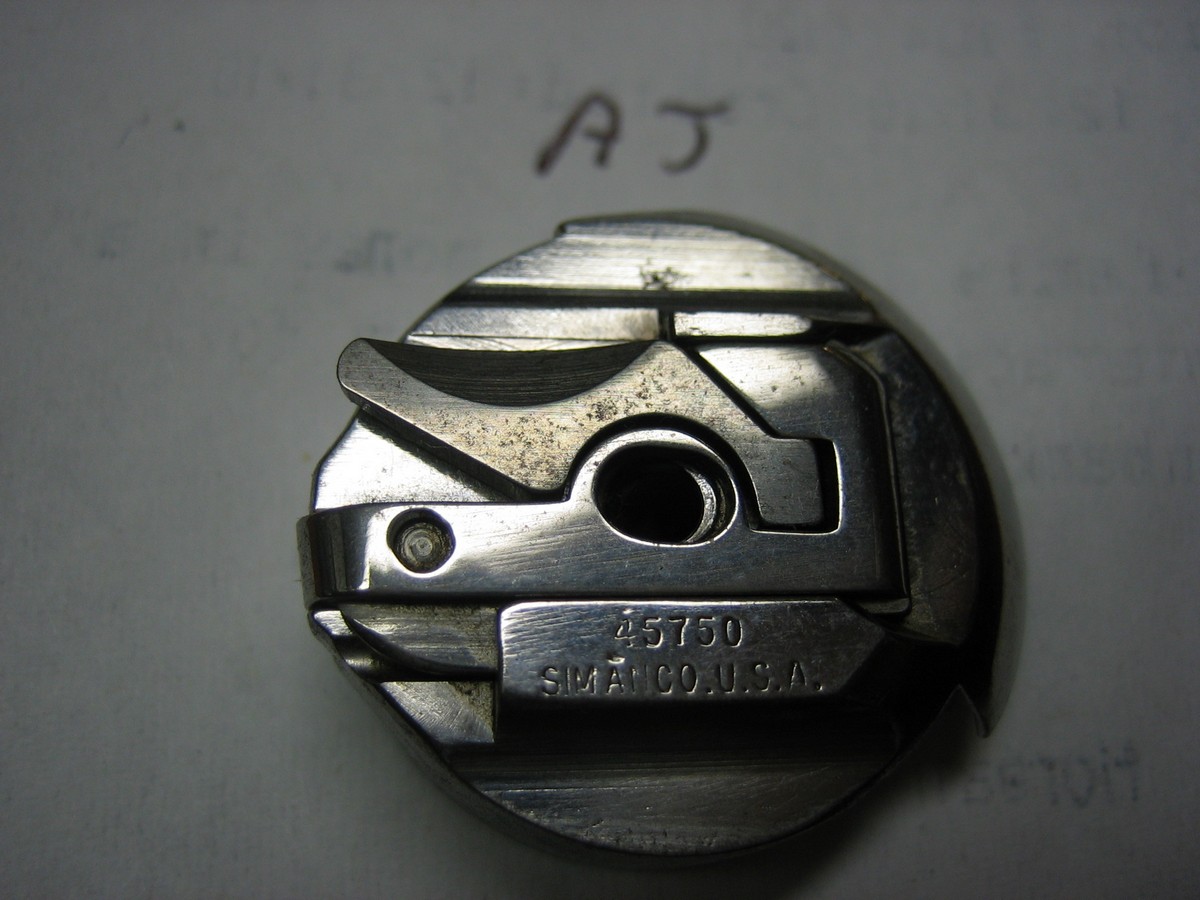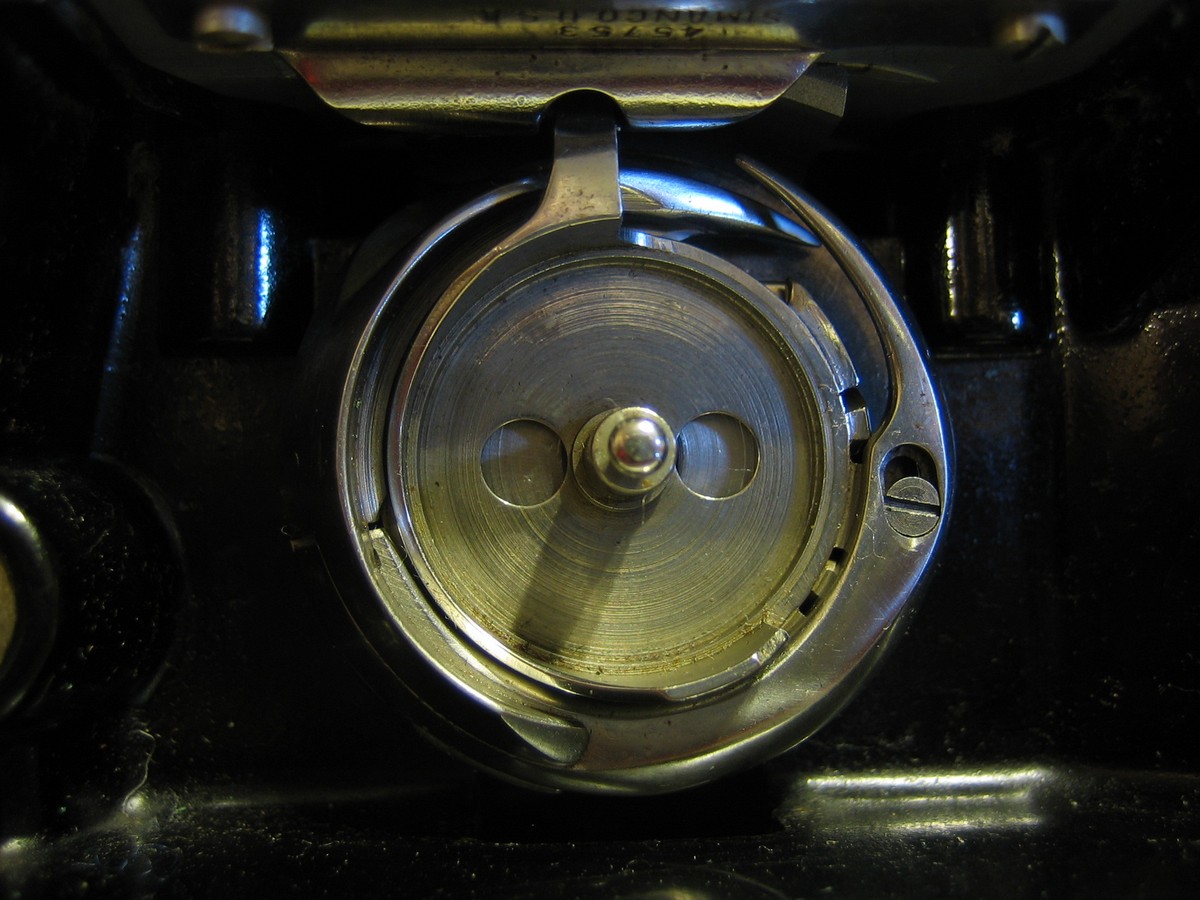The Singer Model 221 “Featherweight” Sewing Machine
BOBBIN CASES, ROTATING HOOK ASSEMBLIES and THROAT PLATES
QUESTION: I have owned 221's for a while now. I would like to get an early model 221 AD series. Every time I see an early AD Model I keep seeing this written about them.
THE IMPROVED MODEL which followed THREE years later, had a RE-WORKED BOBBIN CASE and a NUMBERED DIAL which took the guesswork out of the Tension Setting...
Can you tell me which one is the new improved model, or what this means?
ANSWER: This is another case of Myth and Rumor as I have talked about. About the Only change Singer did to the BOBBIN CASE is Move the Part number around.
 
1933 to 1946 Bobbin Case 1946 and after Bobbin Case
Many people know just enough about the Model 221 to be dangerous and spread more Myth and Rumors. The First 40,000 FEATHERWEIGHTS were ALL called 221's. On JUNE-24-1935 SINGER, FOR ONE PRODUCTION RUN called the FEATHERWEIGHT a 221-1. LOTS of collectors are led to believe SINGER made some wild improvements at this time.. NOT SO!
NOW IF we change the wording a little from BOBBIN CASE to ROTATING HOOK ASSEMBLY, we would be partly right but still wrong.
SINGER had a Problem with the THROAT PLATE. And Singer DIDN'T WAIT THREE Years to fix it. IN FACT Singer knew about it within the FIRST One or Two Hundred machines in 1933. Back in 1933, production capabilities were not able to hold very close tolerances, certainly not like today's computer aided manufacturing capabilites. SINGER soon learned that the 221 could/would run louder and make a clicking sound. Not liked by the sensitive ears of a house wife... (SEE CLICKING SOUND At Leo's TROUBLESHOOTING TIPS)
SINGER began working on the problem some time around AD541746 give or take a few.
SO Next time your looking at a 1933 model 221, Raise the BED and LOOK at the ROTATING HOOK ASSEMBLY and the THROAT PLATE.
YOU WILL SEE 1 of 3 DIFFERENT ROTATING HOOK ASSEMBLY and THROAT PLATE COMBINATIONS....

THIS is an Original 1933 ROTATING HOOK ASSEMBLY and THROAT PLATE. NOTE: The elongated Hole in the GIB where the Screw is on the Rotating Hook Assembly. ALSO NOTE: The UNDERSIDE of the THROAT PLATE....

THIS picture shows an Early 1933 Throat Plate Next to the Later 1933 Throat Plate....

THIS IS THE SECOND combination; old style ROTATING HOOK ASSEMBLY with the Updated THROAT PLATE. Now the Throat Plate can be adjusted to remove any Play or Clicking from the POSITION FINGER.
THE EARLY ROTATING HOOK ASSEMBLY didn't appear to have any real problems. OTHER than being OVER BUILT. IT Looks like SINGER kept using them until the supply was exhausted.

THE THIRD combination (above) of Rotating Hook Assembly and Throat Plate was SINGER'S Final design that was used from Late 1933 to the last American 221 in 1957.....
ROTATING HOOK ASSEMBLY..Here is a Early 1933 Rotating Hook Assembly With Safety Spring. Next to a late 1933 and Later Hook Assembly W/O Spring. You can see they are almost Identical, Less Spring.
 
THE BIG DIFFERENCE with the Early Hook Assembly - IF you had to get to the Base to remove a thread jam, you would have to Completely Remove the Hook Assembly and Re-time the Machine. Not an easy task for a novice.

WITH the new Rotating Hook Assembly, you can Remove the GIB Screw. Push the GIB back and remove the BASE in a matter of seconds and clear that thread jam....

THERE you have it. Another Myth put to rest. Hope we didn't confuse any of you new 221 collectors. LEO and I enjoy bringing you 221 facts and a little history on our beloved 221s. Leo and I welcome your comments..TILL Next time, Stay Safe and Warm. Don't forget, If you need a beautiful 221 or one brought back to it's original beauty? Leo is a Master with an Air Brush.................GOD BLESS
COPYRIGHT (0111) LEO & JJ
|